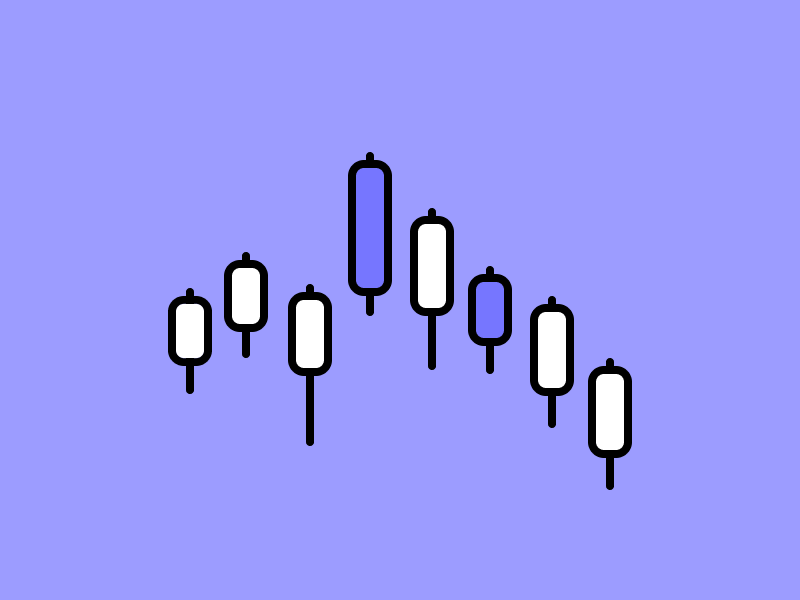What is Metis?

Metis Andromeda has successfully become a scalability solution on the Ethereum network. Not only does it process transactions faster, but transaction fees on Metis are even 100 times lower than Ethereum’s. Furthermore, Metis also has the potential to be the first layer-2 to implement a decentralized sequencer. Are you curious about Metis and their technology? Find out in this article.
Article Summary
- 🌿 Metis Andromeda is Ethereum’s Layer-2 (L2) roll-up protocol that offers simple and fast smart contract deployment to a network.
- 🥇 Thanks to the combination of optimistic roll-up technology and InterPlanetary File System (IPFS) Metis is the Ethereum L2 with the lowest transaction fees.
- ⚡ Metis is currently testing its decentralized sequencer. If successfully implemented, Metis will be the first L2 Ethereum to utilize a decentralized sequencer.
- 🪙 The METIS token is the native token of the Metis ecosystem used for transaction fee payments and staking.
What is Metis?
Metis Andromeda is Ethereum’s Layer-2 (L2) roll-up protocol that offers simple and fast smart contract deployment to a network. It seeks to address the blockchain trilemma– the challenge of simultaneously achieving decentralization, security, and scalability.
Metis aims to help developers improve existing decentralized applications (dApps). In addition, they also provide support for developers who want to develop and introduce new dApps.
This is done by integrating the Decentralized Autonomous Company (DAC) framework in the Layer-2 infrastructure. This will ease the transition for developers and businesses to move from the Web 2.0 ecosystem to the Web 3.0 ecosystem.
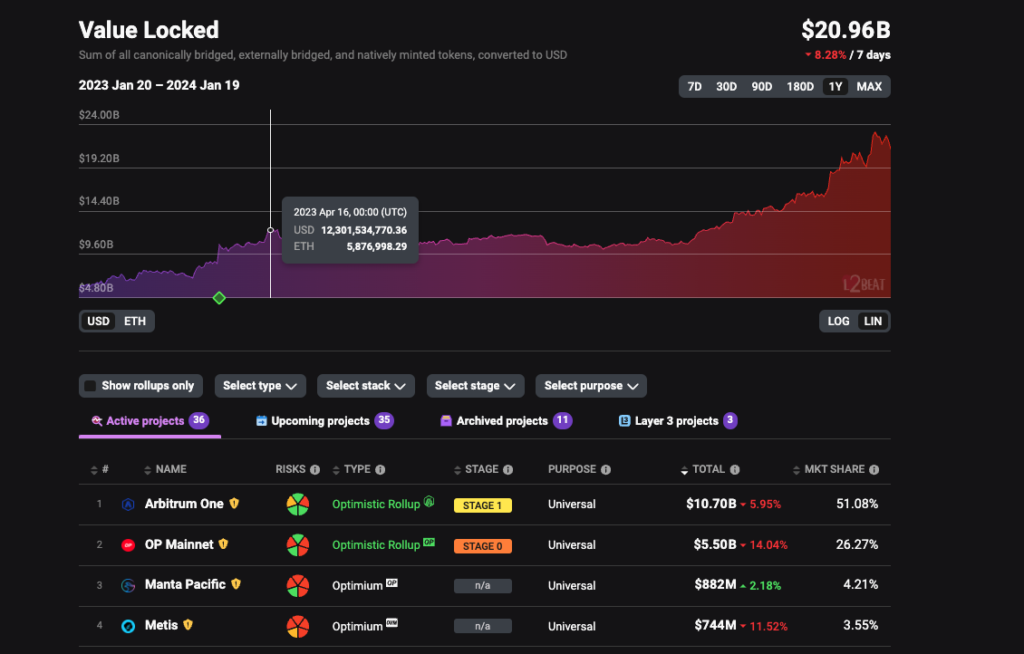
Metis, as a new L2 protocol, has managed to trail the competition. This is reflected in their Total Value Locked (TVL) growth. Based on L2Beat data, Metis ranks fourth with a TVL of US$ 744 million. This record is quite impressive, considering Metis managed to overtake other L2 projects such as Base and zkSync.
You can learn about how L2 works here and the optimistic roll-up technology here.
The Metis Founding Team
Metis was founded by Metis Labs in 2018, but their mainnet was only launched in November 2021. One of the founders of Metis Labs is Natalie Ameneline, Vitalik Buterin’s mother. Other notables include Kevin Liu, Yuan Siu, and Elena Sinelnikova.
In terms of funding, Metis has received support from various venture capitals such as gate.io labs, AU21 Capital, Master Ventures, and many more.
How Does Metis Work?
Metis Andromeda is an L2 with optimistic rollup technology. It rolls up a batch of transactions into one on L2 and sends it back to L1 (Ethereum). However, Metis’ rollup model has a unique hybrid setup. It allows Metis to reduce fees while maintaining fast confirmation times significantly.
One factor that makes this possible is using InterPlanetary File System (IPFS), a decentralized storage space with peer-to-peer architecture. So, instead of storing and processing data off-chain in a centralized location, Metis stores it spread across various nodes in the IPFS network.
In this way, data processing can be more effective while minimizing the risk of data loss or being hacked. Combined with rollup technology, Metis can reduce transaction fees to 100x lower than the Ethereum Mainnet, making it the lowest-cost L2 network on Ethereum.
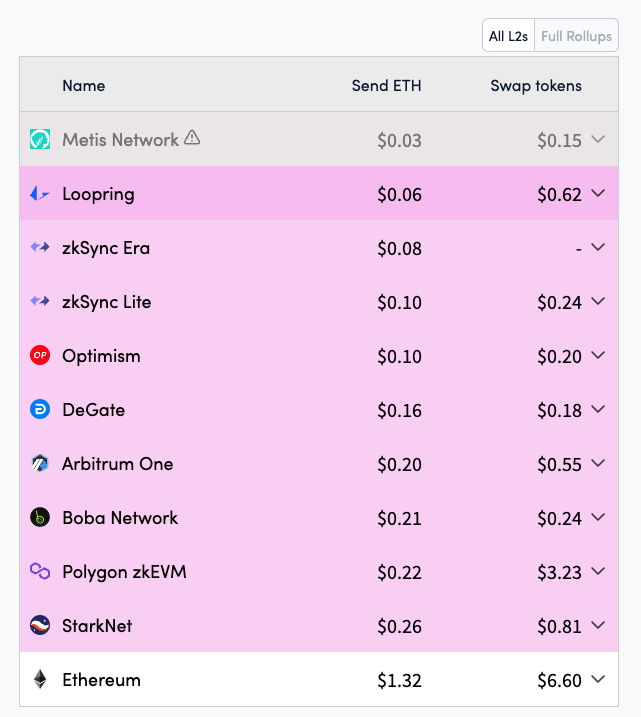
Biaya transaksi jaringan L2 dan Ethereum. Sumber: l2fees
Unlike other L2 platforms with EVM-compatible processing engines, Metis’ engine -Metis Virtual Machine- is EVM-equivalent. This is an advantage of Metis because MVM is better than EVM-compatible.
Regarding security, structure, and programming language (Solidity), MVM is equivalent to EVM. Thus, the development team can easily deploy native Ethereum applications to Metis with slight programming code modification.
Metis Features
In addition to offering a rollup feature, the following are some of the key features offered by Metis:
Decentralized Sequencer
Metis will also be the first L2 to implement a decentralized sequencer. Just like other L2s, Metis currently uses a centralized sequencer. This is the weak point of L2 because if the sequencer node stops working, the entire network will stop.
With a decentralized sequencer, Metis will eliminate the risk of a central point attack. Not only decentralized, Metis also makes the sequencers rotate periodically to prevent malfunctioning or malicious sequencers while strengthening network stability.

Metis’ decentralized sequencer is currently in the testing phase by the Metis community. The decentralized sequencer will be tested for robustness and security through stress tests. If the results are good, it will be launched on the Metis mainnet.
Regarding testnet and mainnet, you can learn how they work and what they are used for in the following article.
Decentralized Autonomous Company Framework
Metis Andromeda is a protocol with community-based governance. However, unlike most other protocols, it does not use the Decentralized Autonomous Organization (DAO) mechanism. Metis uses the Decentralized Autonomous Company (DAC) format.
In DAOs, decision-making will be decided by the owners of governance tokens. The more ownership, the greater the influence on decision-making. Metis sees that this can cause problems because the presence of whales can create a gap. In addition, there is a possibility that DAO participants do not have the technical capabilities related to a proposal.
With the DAC framework, Metis attempts to eliminate this possibility. The developer has created some rules in DAC through smart contracts in advance. Generally, it is based on an organized structure like that of a public company. For example, only certain groups can participate in voting on technical proposals. So, users who are deemed to have no technical knowledge of the proposal will not be involved.
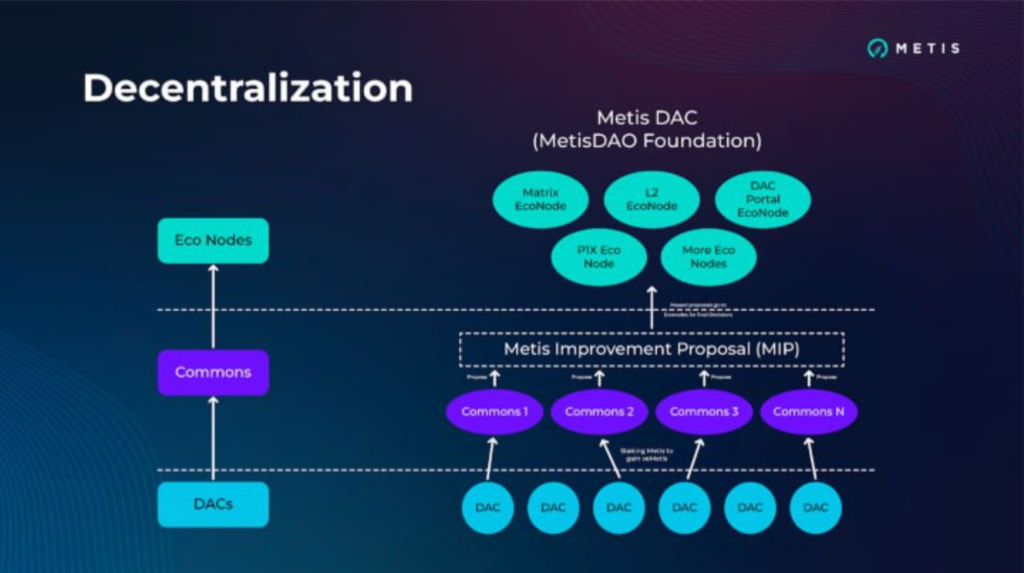
There are two main roles in Metis’ DAC framework: Commons and EcoNodes. Anyone who stakes METIS tokens can create and submit proposals to become a Common. A Common can become an EcoNode based on its contribution to the Metis ecosystem. The use of the DAC framework helps Metis to maintain an efficient, comprehensive, and well-managed decentralized business structure.
Metis Bridge
One of the key features of Metis is Metis Bridge, a tool that helps users to send tokens between L1 and L2. In addition to tokens native to its main networks, ETH and METIS, Metis Bridge also supports various other ETH-based tokens, such as USDT, USDC, LINK, DAI, AAVE, and WBTC.
Metis also has a Metis NFT Bridge that supports sending ERC-721 and ERC-1155 NFT tokens. To overcome the limitations of bridging outside of Ethereum, Metis has implemented an omnichain token transfer protocol through LayerZero. By using third-party bridges, users can now bridge to other blockchain platforms such as Polygon, Avalanche, Fantom, and BNB Chain.
Metis Advantages
- 🤑 L2 Ethereum with the lowest fees. Thanks to IPFS technology and decentralized storage space, Metis can make transaction fees 100x lower than Ethereum transaction fees.
- 🏆 The first L2 to use a decentralized sequencer. The problem with L2 is that the sequencer is centralized, leading to the risk of central point attacks. Metis, with a decentralized sequencer, will eliminate that risk while strengthening its decentralized rollup and network stability.
- 💪 EVM-equivalent MVM. Metis’ MVM works in the same way as Ethereum but with lower fees, and it is faster and easier to use than Ethereum. Moreover, Metis also supports Solidity language smart contracts. This makes it easy for development teams to implement Ethereum-based dApps on MVM.
Read the following article to learn more about EVM.
METIS Token as Investments
METIS is the native token of the Metis Andromeda ecosystem. It can be used for transaction fees and staked to earn rewards and secure the network. Metis also operates a ‘Builder Mining’ program that rewards DAC members for every transaction made on the network.
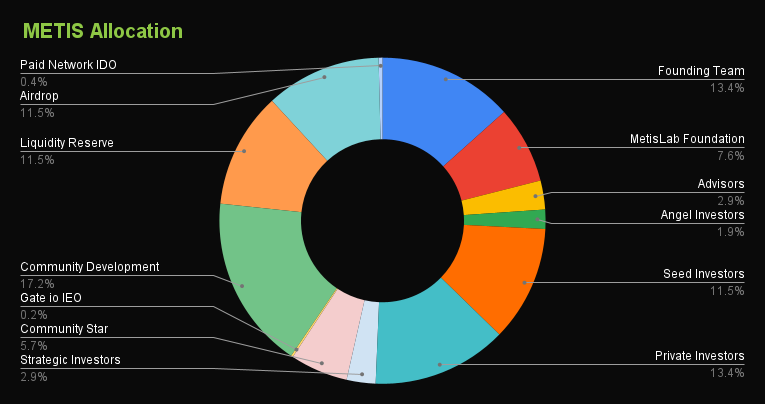
Regarding tokenomics, METIS has a maximum supply of 10 million tokens. A total of 49.3% of the total supply has been minted in 2021. The tokens were distributed to Metis cold launch, core team, angel investors, and ecosystem/community development. Meanwhile, the remaining 50.7% is distributed to the community (4.86%), early-stage rangers mining (10%), and Discovery Age community development (35.84%).
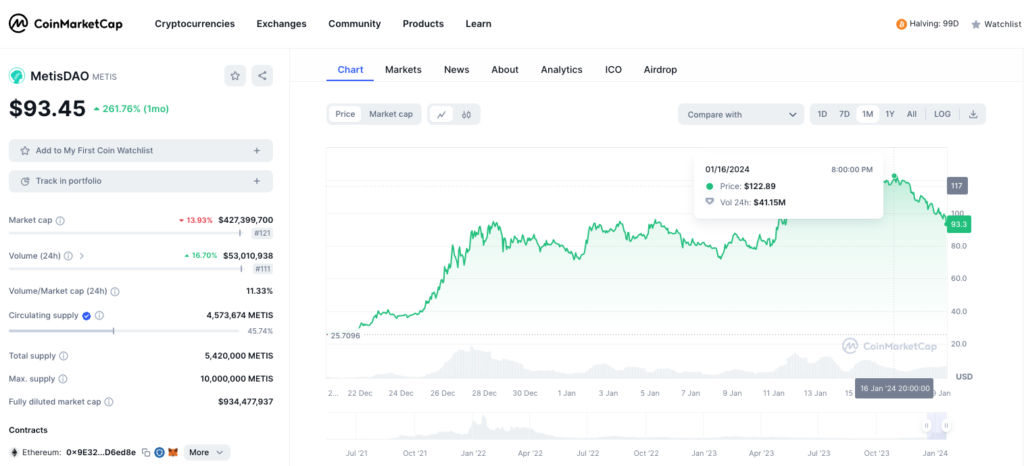
METIS’ total supply currently stands at 5.42 million, with 4.57 million in circulation. As of January 19, 2024, its market capitalization touched US$ 426 million with a METIS price of US$ 93.34. METIS reached its highest level of US$ 122.89 on January 17, 2024.
Metis recently announced an ecosystem incentive of 4.6 million METIS tokens (equivalent to US$ 330 million) to accelerate the adoption of the Metis ecosystem. The incentive will be given to development teams that develop dApps using Metis’ rollup by January 2024.
Incentive mechanisms like this have triggered significant user growth and liquidity. For example, Avalanche provided its ecosystem development with a US$ 180 million incentive program. Within 90 days, the AVAX token price rose from US$ 20 to US$ 160, and its TVL rose from US$ 200 million to US$ 11.4 billion.
Thus, Metis may experience a significant surge after the Metis Ecosystem Development Fund (Metis EDF) program. This could be a positive catalyst for METIS tokens.
Conclusion
Metis Andromeda is the lowest-fee Layer-2 roll-up protocol on Ethereum. Thanks to implementing optimistic roll-up technology and IPFS, Metis can reduce transaction fees up to 100x lower than Ethereum. In addition to scalability solutions through roll-up technology, Metis has features such as Decentralized Autonomous Company (DAC), Metis Bridge, and MVM, an EVM-equivalent engine.
Metis’ native token, METIS, is used for transaction fees and staking. METIS has a maximum supply of 10 million tokens. Committed to growing its ecosystem adoption, Metis has announced a token distribution similar to the successful Avalanche incentive program.
How to Buy METIS Token on Pintu
After knowing what Metis is, you can start investing in METIS by buying it on Pintu app. Here is how to buy crypto on Pintu application:
- Create a Pintu account and follow the process of verifying your identity to start trading.
- On the homepage, click the deposit button and top up the Pintu balance using your preferred payment method.
- Go to the market page and look for METIS.
- Click buy and fill in the amount you want.
- Now you have METIS!
In addition to METIS, you can safely and conveniently purchase a wide range of cryptocurrencies such as BTC, ETH, SOL, and others safely and easily on Pintu. Pintu diligently evaluates all its crypto assets, highlighting the significance of being cautious.
Pintu is also compatible with popular wallets such as Metamask to facilitate your transactions. Download Pintu app on Play Store and App Store! Your security is guaranteed because Pintu is regulated and supervised by Bappebti and Kominfo.
Aside from buying and trading crypto assets, you can expand your knowledge about cryptocurrencies through various Pintu Academy articles. Updated weekly, all Pintu Academy articles are made for knowledge and educational purposes, not as financial advice.
References
- Metis Docs, Building On Metis L2, accessed on 18 January 2024.
- Metis Blog, Community Testing for the Metis Decentralized Sequencer: Official Guide, accessed on 18 January 2024.
- Metis Blog, Metis EDF: A New Chapter for Metis, accessed on 18 January 2024.
- Thor Hartvigsen, A breakdown of Metis, X, accessed on 19 January 2024.
- Fransesco, Here’s an ecosystem guide to Metis, X, accessed on 19 January 2024.
Share
